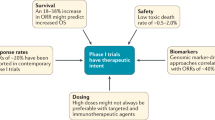Similar content being viewed by others
References
Norton L and Simon R (1976) Tumor size, sensitivity to therapy and the design of treatment protocols. Cancer Treat Rep 61: 1307–1317
Norton L and Simon R (1977) The growth curve of an experimental solid tumor following radiotherapy. J Natl Cancer Inst 58: 1735–1741
Norton L and Simon R (1986) The Norton-Simon hypothesis revisited. Cancer Treat Rep 70: 163–169
Skipper HE (1986) Laboratory models: some historical perspectives. Cancer Treat Rep 70: 3–7
Norton L et al. (1976) Predicting the course of Gompertzian growth. Nature 264: 542–545
Bonadonna G et al. (1995) Sequential or alternating doxorubicin and CMF regimens in breast cancer with more than three positive nodes. Ten-year results. JAMA 273: 542–547
Bonadonna G et al. (2004) Clinical relevance of different sequencing of doxorubicin and cyclophosphamide, methotrexate and fluorouracil in operable breast cancer. J Clin Oncol 22: 1614–1620
Goldie JH and Coldman AJ (1979) A mathematical model for relating the drug sensitivity of tumors to their spontaneous mutation rate. Cancer Treat Rep 63: 1727–1733
Citron ML et al. (2003) Randomized trial of dose-dense versus conventionally scheduled and sequential versus concurrent combination chemotherapy as postoperative adjuvant treatment of node-positive primary breast cancer: first report of Intergroup trial C9741/Cancer and Leukemia Group B trial 9741. J Clin Oncol 21: 1431–1439
Venturini M et al. (2005) Dose-dense adjuvant chemotherapy in early breast cancer patients: Results from a randomized trial. J Natl Cancer Inst 97: 1724–1733
Norton L (2005) Conceptual and practical implications of breast tissue geometry: toward a more effective, less toxic therapy. Oncologist 10: 370–381
Norton L et al. (2005) Optimizing chemotherapeutic dose-schedule by Norton-Simon modeling: capecitabine. In 96th Annual Meeting of the American Association of Cancer Research: 2005 April 16–20; Anaheim, abstract #5007
Author information
Authors and Affiliations
Corresponding author
Ethics declarations
Competing interests
The authors declare no competing financial interests.
Supplementary information
Rights and permissions
About this article
Cite this article
Simon, R., Norton, L. The Norton–Simon hypothesis: designing more effective and less toxic chemotherapeutic regimens. Nat Rev Clin Oncol 3, 406–407 (2006). https://doi.org/10.1038/ncponc0560
Received:
Accepted:
Issue Date:
DOI: https://doi.org/10.1038/ncponc0560
- Springer Nature Limited
This article is cited by
-
Digital twins in oncology
Journal of Cancer Research and Clinical Oncology (2023)
-
AML consolidation therapy: timing matters
Journal of Cancer Research and Clinical Oncology (2023)
-
Games and the Treatment Convexity of Cancer
Dynamic Games and Applications (2023)
-
Dose-dense sequential adjuvant chemotherapy in the trastuzumab era: final long-term results of the Hellenic Cooperative Oncology Group Phase III HE10/05 Trial
British Journal of Cancer (2022)
-
Sequential vs concurrent adjuvant chemotherapy of anthracycline and taxane for operable breast cancer
World Journal of Surgical Oncology (2021)




